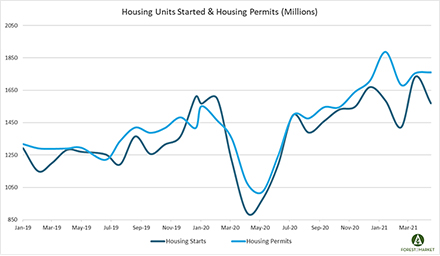After cresting a 15-year high in March fuelled by a breakneck building pace in the United States Midwest (where total housing starts were up nearly 123% month-over-month), homebuilding reversed course and surprisingly dropped in April. Source: FOREST2MARKET
Privately-owned housing starts decreased 9.5% in April to a seasonally adjusted annual rate (SAAR) of 1.569 million units.
Single-family starts decreased 13.4% to a rate of 1.087 million units. Starts for the volatile multi-family segment rose 0.8 percent to a pace of 482,000 units.
Privately-owned housing authorizations were up 0.3% to a rate of 1.760 million units in April and single-family authorizations were down 3.8% to a pace of 1.149 million units.
Privately-owned housing completions were down 4.4% to a SAAR of 1.449 million units. Per the US Census Bureau Report, seasonally adjusted MoM total housing starts by region included:
- Northeast: +6.2% (+64% last month)
- South: -11.5% (+13.5% last month)
- Midwest: -34.8% (+122.8% last month)
- West: +9.0% (-13.6% last month)
Seasonally-adjusted MoM single-family housing starts by region included:
- Northeast: -13.0% (+28.6% last month)
- South: -12.5% (+10.9% last month)
- Midwest: -32.3% (+109% last month)
- West: 0.0% (-12.6% last month)
The tumble in April housing starts was concentrated in the single-family segment, which supports speculation that supply chains for construction materials are simply stressed beyond capacity.
“Builders are delaying starting new construction because of the marked increase in costs for lumber and other inputs,” said Mike Fratantoni, Chief Economist at the Mortgage Bankers Association.
“These supply-chain constraints are holding back a housing market that should otherwise be picking up speed, given the strong demand for buying fuelled by an improving job market and low mortgage rates.”
The 30-year fixed mortgage rate ticked down in April from 3.08 to 3.06, and speculation is that rates are likely to increase in the coming months.
According to fresh housing market insights the pace of new home sales has surged as eager buyers poured into the new-construction market amid a shortage of existing homes for sale (evidenced by a 3.7% decline in resales).
Household migration, motivated by a variety of quality-of-life reasons, may have contributed to surging new-home sales and falling resales: E.g., escaping the potential for civil unrest that has been more prevalent in urban environments; taking advantage of the growing acceptance of remote work; shifting to states with less restrictive virus-control policies; and to be closer to family.
Because of the strong demand for new homes, skyrocketing lumber prices seem to have had little impact on builders’ positive outlook.
“While mortgage interest rates have trended higher since February and home prices continue to outstrip inflation, housing demand appears to be unwavering for now as buyer traffic reached its highest level since November,” said NAHB’s Robert Dietz.
“NAHB’s forecast is for ongoing growth in single-family construction in 2021, albeit at a lower growth rate than realized in 2020.”
The run-up in lumber prices appears to still “have legs,” especially given the fact that lumber futures trading has been halted on multiple occasions since mid-April because prices “limited up” (rose by more than US$32 during a single trading day).
“It’s clearly a short squeeze” in futures and spot markets, said Deacon Lumber’s Stinson Dean.
“Lumberyards are over committed on their sales, and there isn’t enough wood to cover.”
This is a clear signal, Mr Dean says, that prices will go up more in the short term despite wood production hitting a 13-year high in February.








